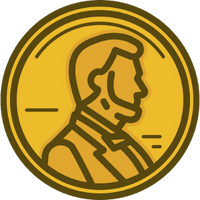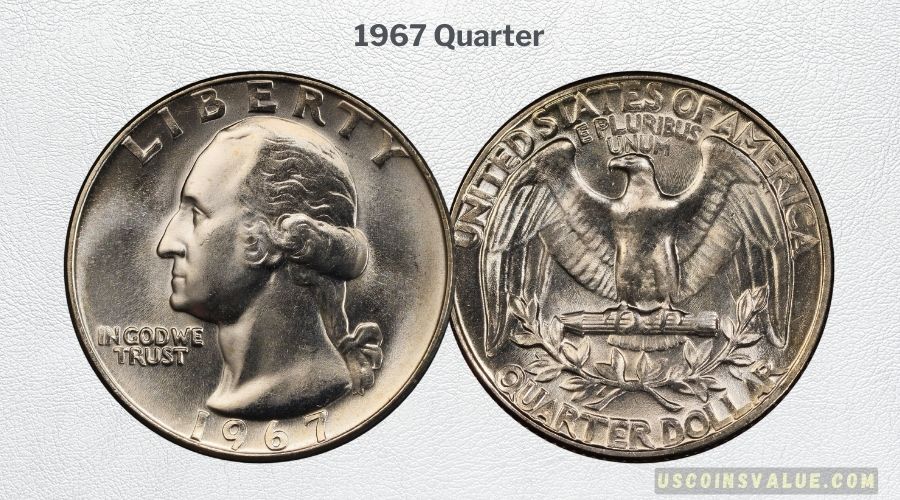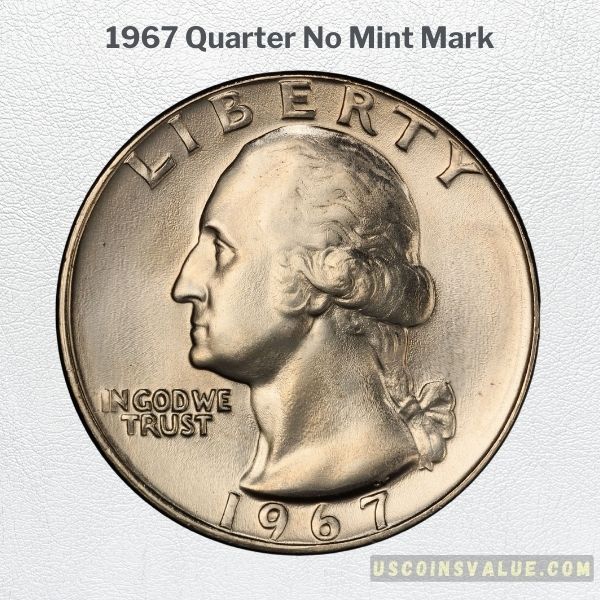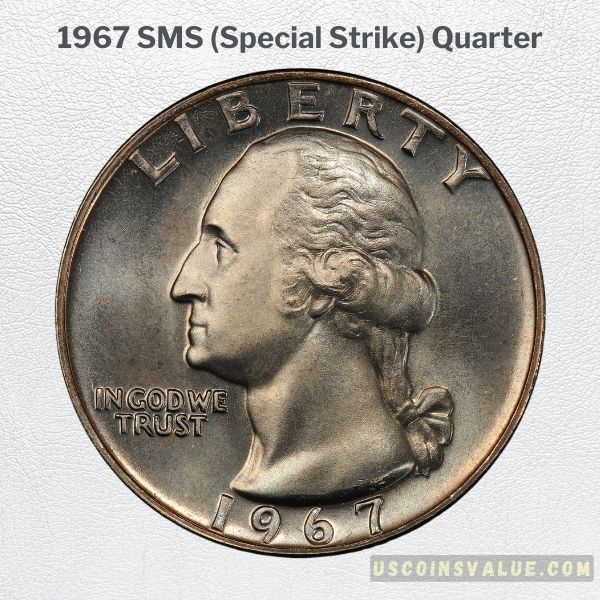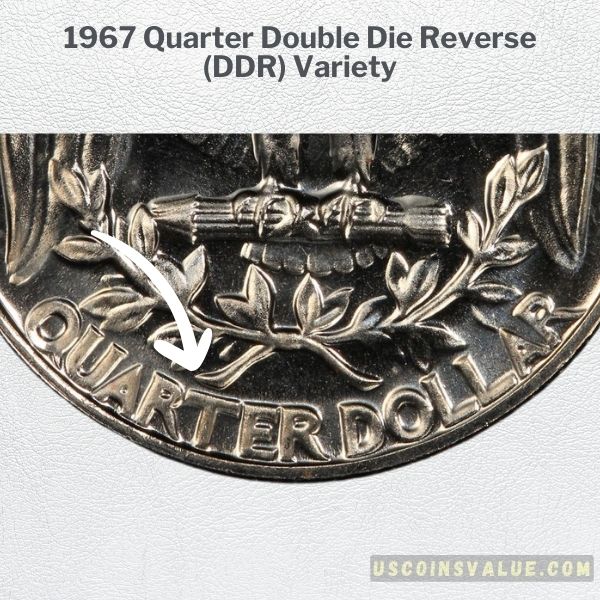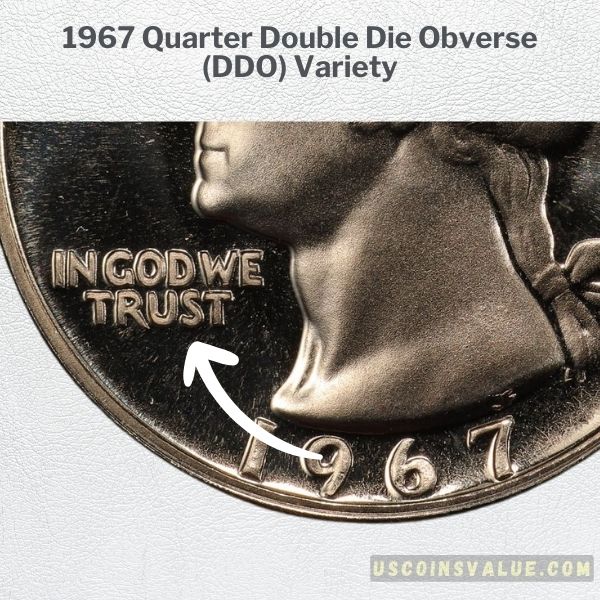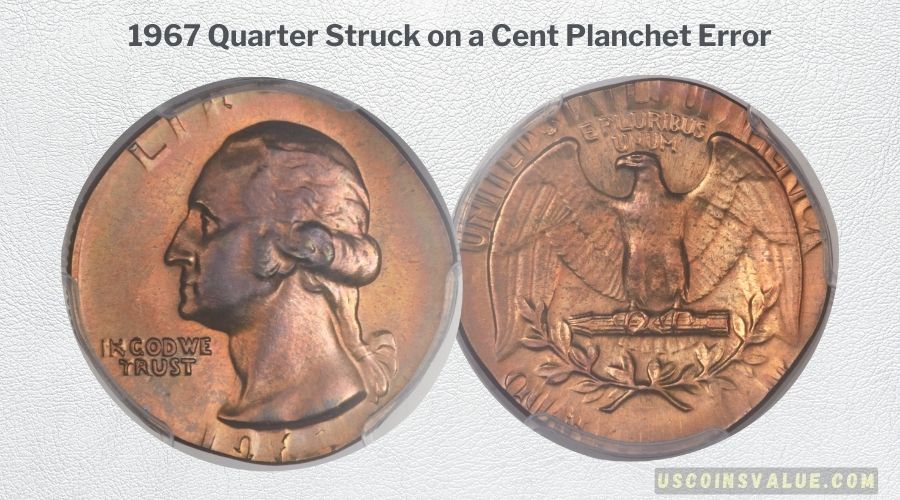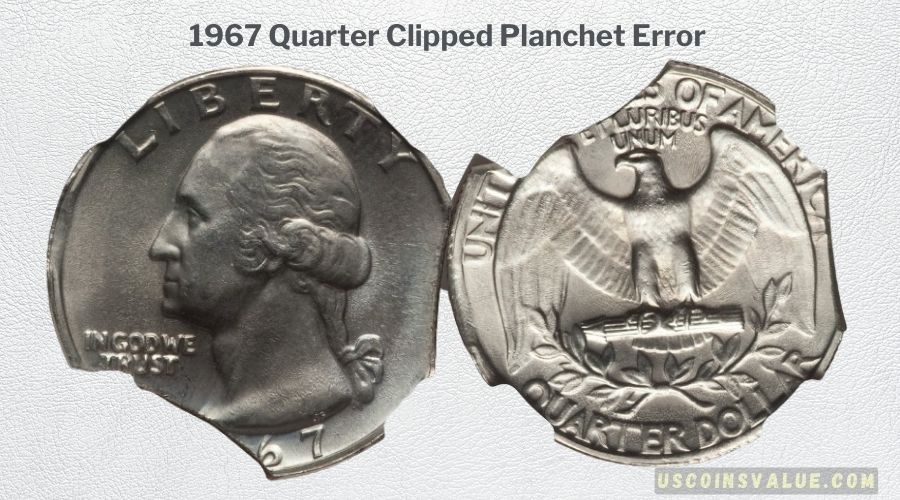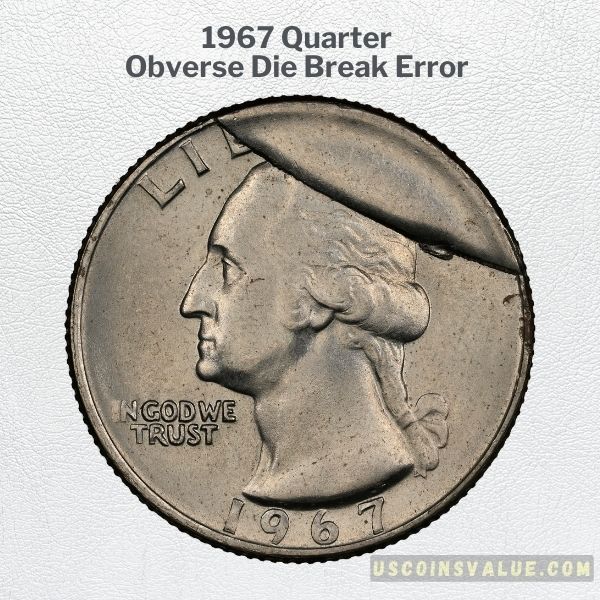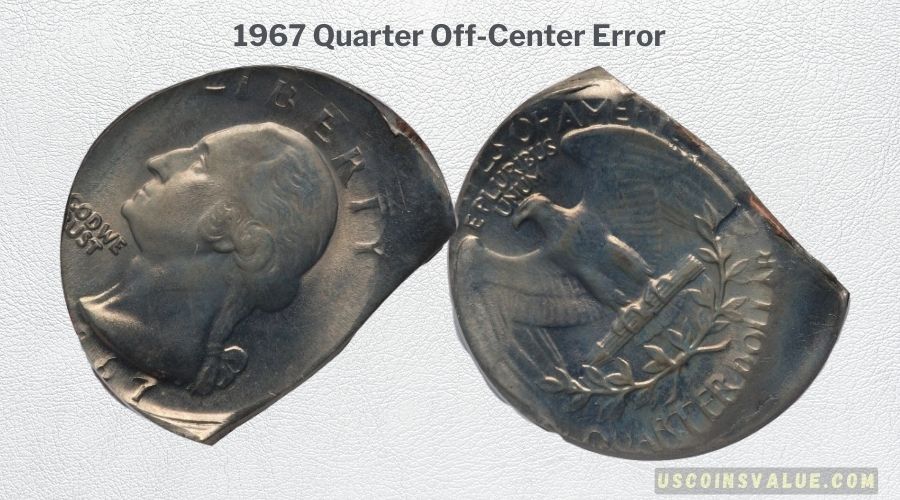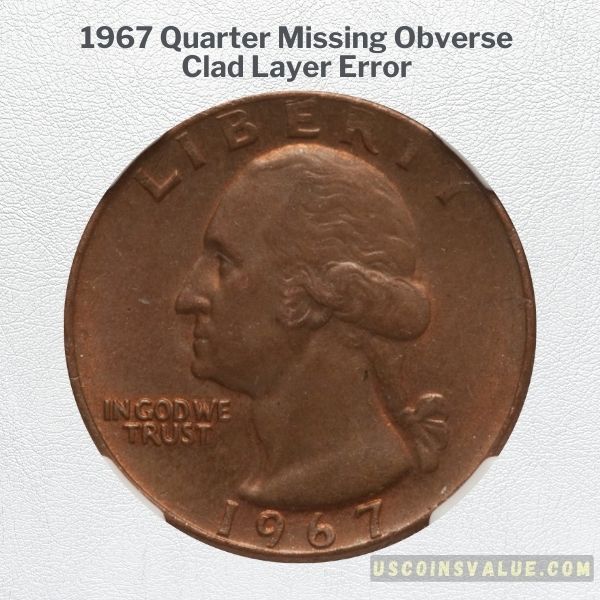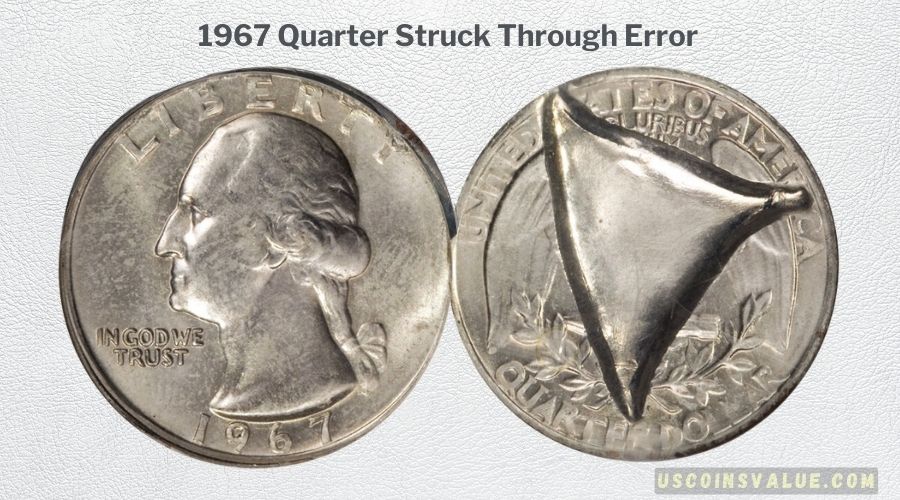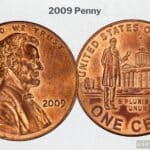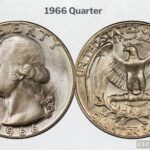The value of 1967 quarters can be summarized into three categories:
- The highest grades (MS68, SP68 DCAM, SP69 CAM) are the most valuable, worth over $3,000. The lowest grades (<MS60, <SP60) are the cheapest, valued at less than $1.
- Rare errors increase value. Coins with unique errors like ‘Wrong Planchet’ are worth more than $200, while those with DDO and DDR errors are valued at more than $40 in average conditions.
- 1967 Special Strike (SMS) quarters are more attractive in the collectors’ market with a higher demand. Worth $14 – $600 in average conditions.
With this in mind, here is a comprehensive look at all the 1967 quarters, their history, design, features, errors, and value in today’s market. This is an in-depth resource for enthusiasts and collectors who want to know if their 1967 quarters are worth anything.
1967 Washington Quarter Value Summary
Below is the 1967 quarter value chart based on grade condition and strike:
| 1967 Quarter and Coin Grade | 1967 Quarter No Mint Mark (MS) | 1967 Quarter Special Strike (SP – DCAM) (PR) |
| 60 | <$1 | $2 – $3 |
| 61 | <$1 | $3 – $4 |
| 62 | <$1 | $4 – $5 |
| 63 | $1 | $5 – $10 |
| 64 | $12 – $14 | $12 – $20 |
| 65 | $20 – $24 | $14 – $35 |
| 66 | $28 – $40 | $16 – $250 |
| 67 | $135 – $850 | $26 – $600 |
| 68 | $6,000 | $50 – $3,400 |
| 69 | N/A | $150 – $4,500 |
| 70 | N/A | N/A |
Note:
- The N/A in columns without a price guide does not mean the coins are rare. Instead, it shows there isn’t enough data or coins to publish an average price estimate.
- The grades (60 – 70) represent the particular coin’s grading prefix, i.e., MS60-MS70 for Regular Strike coins and SP60-SP70 for Special Strike quarters.
1967 Washington Quarter Background
1967 quarters are part of the Washington Quarter Series (Type 2, Clad) that consists of clad composition coins made from 1965 to 1998.
They feature the iconic George Washington portrait on the obverse and the eagle on the reverse.
Prior to 1965, quarters were primarily composed of 90% silver and 10% copper. However, the United States Mint sought a more economical alternative due to the rising price of silver and the increasing demand for coinage.
In 1965, the Mint transitioned to a copper-nickel-clad composition for quarters, a decision that would impact the 1967 quarters as well.
The United States Mint only produced two types of 1967 quarters, both of which did not bear any mint mark:
- 1967 No Mint Mark Quarter – Made in Philadelphia. They are Regular Strike coins made for circulation and used in everyday commerce.
- 1967 Special Strike (SMS) – Made in San Francisco. These are uncirculated coins made for numismatic purposes and sold directly to collectors in sets. They feature a unique satin finish with a nice and smooth appearance.
Here is a quick summary of the coin’s mintage and metal composition:
| Coins | Mint | Total Mintage | Metal Composition |
| 1967 No Mint Mark Quarters | Philadelphia | 1,524,031,848 | 91.67% copper and 8.33% nickel |
| 1967 SMS Quarters | San Francisco | 1,863,344 | 91.67% copper and 8.33% nickel |
Other features:
- Obverse (heads) design: Features George Washington’s portrait facing the left side, designed by John Flanagan.
- Reverse (tails) design: Features a bald eagle perched on a bundle of arrows with its wings outstretched. Two olive branches hang below the eagle.
- Weight: 5.67 grams
- Diameter: 24.30 millimeters
- Edge: Reeded
How Do I Know If My 1967 Quarter Is Worth Anything?
1967 quarters were minted in plenty, with over 1.5 billion put into circulation. Even though they are generally common and easily found in change, the highest grades are harder to come by and these scarce coins are the most valuable quarters in this year.
To know the true value of your 1967 quarters, ensure you gauge their worth based on these three conditions:
1. Coin Condition
PCGS (Professional Coin Grading Service) and the NGC (Numismatic Guaranty Company) are the most prominent coin graders of American coins such as the 1967 quarters.
They both use the Sheldon Scale to gauge the coin condition of these quarters using the ANA (American Numismatic Association) Grading Standards from the 1970s.
In the Sheldon Scale, the quarters are graded based on their physical characteristics and appearance. Poor (P-1) is the lowest grade and Mint State 70 (MS70) is the highest grade.
Since collectors prefer the best grades of any coin, 1967 quarters in the most pristine condition always garner the best prices at auctions. These include uncirculated coins graded between MS60 – MS70; the higher the grade, the higher the price.
From historical sales records, 1967 quarters graded MS67 and above are the most valuable, worth more than $1,000 on various auctions, including Heritage Auctions and Stack’s Bowers.
Mid-range grades like AU-58 (circulated coins with the appearance of uncirculated coins) are also valuable. Low-grade coins are circulation coins graded between P-1 and EF-45, these varieties are worth their face value or below $1 depending on the severity of their wear.
2. SMS Coins
The U.S. Mint did not produce any Proof Coins in 1967. This is because of a change that took place in 1965 when there was a short supply of coins in the market.
Due to the rising costs of silver, many citizens hoarded coins from 1964, primarily made of 90% silver. This led to a need for more coins in daily commerce. In 1965, when the Mint switched to clad composition quarters, they also increased the production of circulation coins to deal with the shortage.
Most resources were put into circulation coins, leaving behind the production of Proof Coins in the meantime. However, the Mint still had to make coins specifically for collectors without incurring much cost, and that is where the Special Strike (SMS) coins came about.
SMS stands for Special Mint Set. These coins feature a distinctive satin finish that is visually appealing to collectors even though they aren’t as vibrant as the Proof Coins.
Over the years, 1967 SMS quarters have become popular in the collector’s market, selling for more than $4,000 in their best grades.
According to the Sheldon Scale, uncirculated SMS coins are graded using MS60 – MS70 or SP60 – SP70 prefixes. The use of either depends on the coin grading service; PCGS uses SP, while NGC uses MS.
SMS coins’ conditions can also be graded according to the exceptionality of the strike: DCAM, CAM, and SP.
DCAM has the highest quality strikes with sharp details and deep frosting. CAM coins have the second-highest level of quality, exhibiting frosting but not as deep as that of DCAM coins. SP (Specimen Strike) is the least striking of the three but still features extra sharp details and clean surfaces.
Note: DCAM coins on NGC are labeled as Ultra Cameo.
3. Mint Errors
1967 quarters are some of the most error-filled 1960s coins with many recorded cases of “Wrong Planchet”, “Die Break”, DDO, DDR, and “Clipped Planchet” errors.
These mint errors are mistakes that occurred during the minting process, causing the struck coins to have variations in designs, shape, weight, and sometimes composition. Their uniqueness increases the value of quarters.
However, if the error is common, then it will not significantly affect the price of the coin. We will dive more into the rare 1967 quarter errors that make the coins more valuable.
1967 Quarter Value
Below is the value of each 1967 quarter based on the mint varieties:
1. 1967 Quarter No Mint Mark Value
Since the coin condition mainly determines the value, the most valuable 1967 no mint mark quarters are those in the highest and rarest grades.
In this case, the best grades are MS67 or higher. MS67 is more common than MS68, but MS69 is almost non-existent, with only a few known handfuls.
The USA Coin Book values the quarters at $6.81 or more in Brilliant Uncirculated Condition (MS65).
On online marketplaces like eBay, the MS67 coins sell for about $50, making them the most profitable, easily accessible 1967 quarters.
However, coin auctions are the places to go for the best value. The table below shows the highest auction prices realized for these 1967 quarters from Philadelphia:
| Grade | Price | Firm | Sale Date |
| MS68 | $8,813.50 | Heritage Auctions | 2017 |
| AU58 | $5,750 | Stack’s Bowers | 2009 |
| MS67+ | $5,170 | Heritage Auctions | 2016 |
| MS68 | $5,040 | Heritage Auctions | 2019 |
| MS68 | $4,800 | Heritage Auctions | 2020 |
2. 1967 SMS (Special Strike) Quarter Value
Online sales for the 1967 SMS quarters value them at $3 – $10 for SP65, while SP66 coins can be easily found for about $25.
SP67 and above are much scarcer, with a valuation of more than $26 in Regular SP condition, more than $400 in CAM, and above $600 in DCAM.
The most common grades are SP63 – SP67, with over 3,700 graded coins on NGC and over 2000 on PCGS. SP69 CAM and SP68 DCAM are the rarest and most valuable, with less than 100 coins graded across both platforms.
Regular SP69 coins are worth $150 – $1,600, SP69 CAM is worth $1,900 – $4,500, and SP68 DCAM is valued at $3,400 or more.
The table below shows the highest auction prices realized for the 1967 SMS quarters:
| Grade | Price | Firm | Sale Date |
| SP69 CAM | $4,700 | Heritage Auctions | 2016 |
| SP68 DCAM | $4,465 | Heritage Auctions | 2017 |
| SP68 DCAM | $4,230 | Heritage Auctions | 2016 |
| SP68 DCAM | $3,525 | Heritage Auctions | 2017 |
| SP69 CAM | $3,120 | Heritage Auctions | 2022 |
Most Valuable 1967 Quarter Errors
Below are the most valuable 1967 quarter errors to look out for:
1. Double Die Reverse (DDR) Variety
Normally, DDR and DDO errors are found in circulation coins. However, this was not the case for the 1967 quarters. DDR and DDO errors emerged in the SMS varieties.
These errors, caused by imperfections in the dies used to strike the coins, resulted in doubled details on the design elements, making them highly sought-after.
It is important to note that there is no known DCAM quarter with the DDR error. You are bound to make more than $500 if you find one.
DDR coins graded SP64 are worth $60 or more, while SP67 or higher are valued at $200 or more. More pristine SP65 CAM coins with this error are worth more than $150 and the most valuable are the SP67 CAM worth $550 or more.
For example, one SP67-graded coin sold for $223.97 in 2019 on eBay and another for $120 at Heritage.
2. Double Die Obverse (DDO) Variety
Regular SP coins above SP64 are worth $60 or more, and SP60 or higher are worth $40 or more. Quarters with DDO error graded above SP65 CAM are worth $225 or more. The most valuable is the SP67 CAM, which is worth more than $250.
There have yet to be any known DCAM varieties with the DDO error. A quick look on eBay will show you 1967 quarters with DDO errors worth $40 – $90.
SP67 CAM sold for $449 in 2019 on eBay and another for $288 at Heritage Auctions.
3. Wrong Planchet Error
Most “Wrong Planchet Errors” in the 1967 quarters are “Struck on a Cent Planchet” coins sold at auctions for more than $700 in MS63 or higher.
This error occurred when 1967 quarters were struck on planchets meant for different coins.
Below is an MS65 coin with a “Struck on a Cent Planchet” error that sold for $2,115 in 2013. It is by far the most valuable error coin in the entire 1967 quarter lineup.
Other examples include the MS63 coin sold for $1,437.50 in 2005 and another in MS66 sold for $1,116.25 in 2015.
eBay has several listings of these errors worth $200- $600 per coin.
Also, note that these errors are not all the same. Some include multiple errors like the “Double Struck on 1C Planchet” coin that has a Double Struck and Wrong Planchet error. It sold for $1,560.
4. Clipped Planchet Error
This mistake occurs when a coin is struck with an incomplete planchet with missing (clipped) edges.
Clipped planchet errors also lead to curved clip errors – a specific type of clipped planchet error where the missing portion along the edge is curved. It is different from straight-clipped planchet errors where the missing metal creates a straight-clipped edge on the coin’s surface.
If the planchet has multiple clipped edges, say three, it will strike a coin with a triple curved clip like the one below that sold for $282 at Heritage.
You can find some curved clip error coins online for about $10 – $90, depending on the severity of the error and the coin’s grade.
5. Die Break Error
Die Break errors happen when a crack develops on a die surface used to strike a coin, the resulting coin will then have a raised feature that is caused by the missing part on the die.
An example of this is this MS65 quarter that sold for $372 in 2022.
6. Off-Center Error
When the dies used to strike the coins do not align properly, then the resultant coin can exhibit an off-center error where part of the coin’s design is misaligned with the struck coin. The degree of off-center can vary from as low as 5% to as high as 60%.
Sometimes, the error can also be accompanied by a clipped planchet error like this MS66 coin that sold for $204 in 2023.
7. Missing Obverse Clad Layer Error
Valued at $30 – $120 on eBay, this error is somewhat common but yet valuable.
The error is caused by issues with the bonding of layers during the planchet preparation. 1967 quarters with this error have partially or fully missing outer layers (composed of copper-nickel clad) and are only made up of the inner core (copper).
An example is the MS64 coin that sold for $84 in 2011.
8. Struck Through Error
Online marketplaces evaluate coins with this error between $3 – $30. One example, MS64 graded, sold for $488.75 in 2008.
The Strike Through errors happens when foreign materials fall between the dies and planchet during the striking process. This causes the material to leave an impression on the coin’s surface after it’s struck, as seen in the example above.
Conclusion
All in all, if you’re looking for valuable 1967 quarters, start by examining the coin’s condition and mint errors.
High grades (MS67 and above) and unique errors significantly increase the coin’s value by a few hundred dollars or more. Additionally, 1967 SMS quarters, with their distinctive satin finish, are highly sought after by collectors and will be worth more than $14 – $600.
